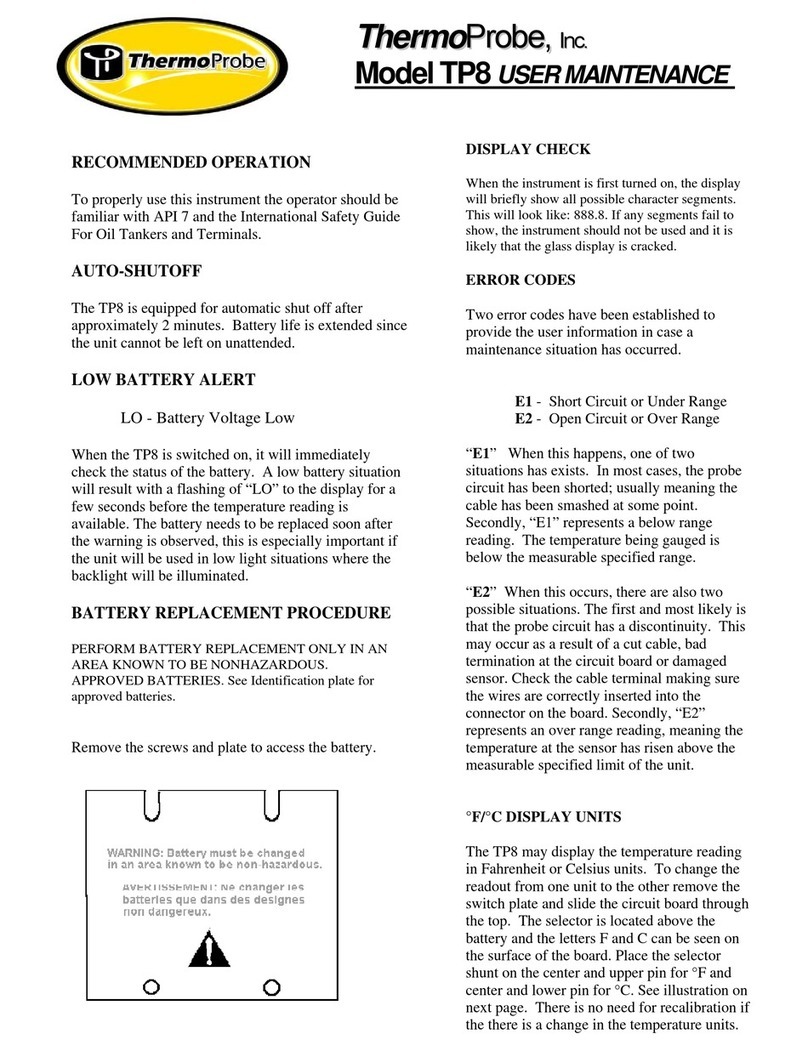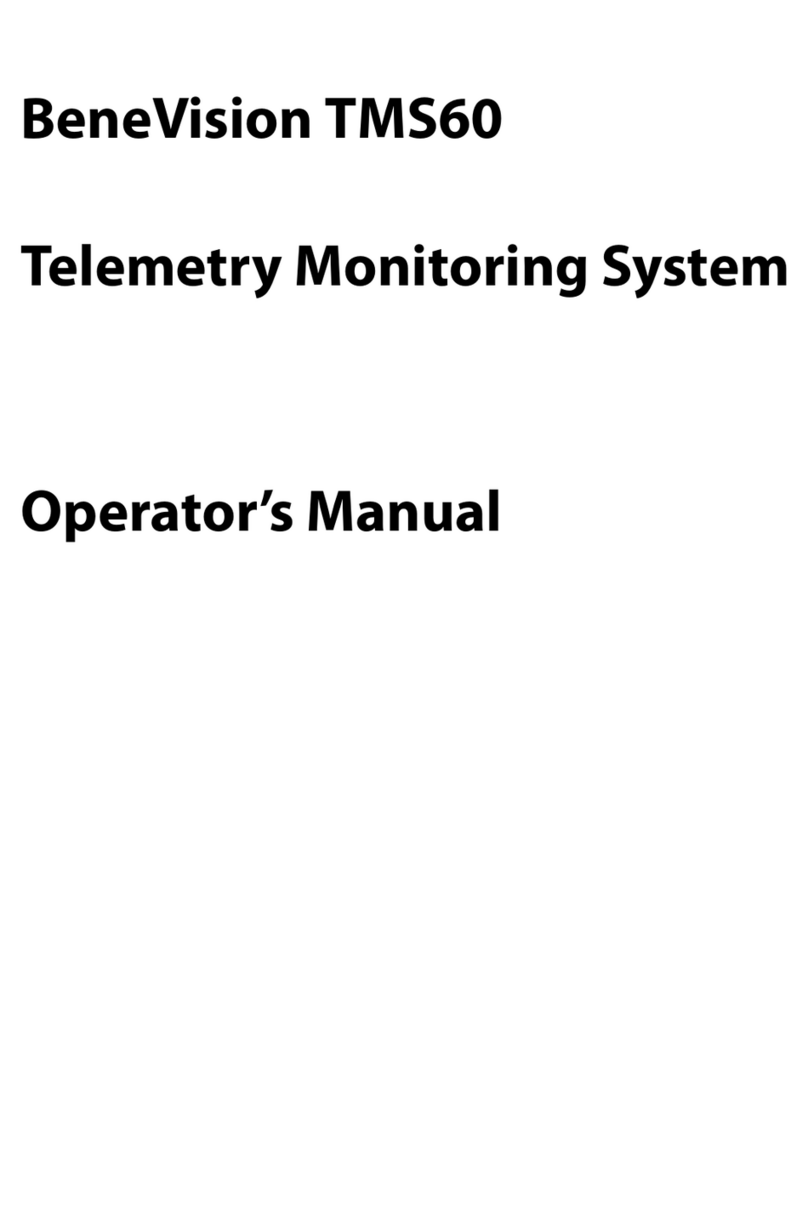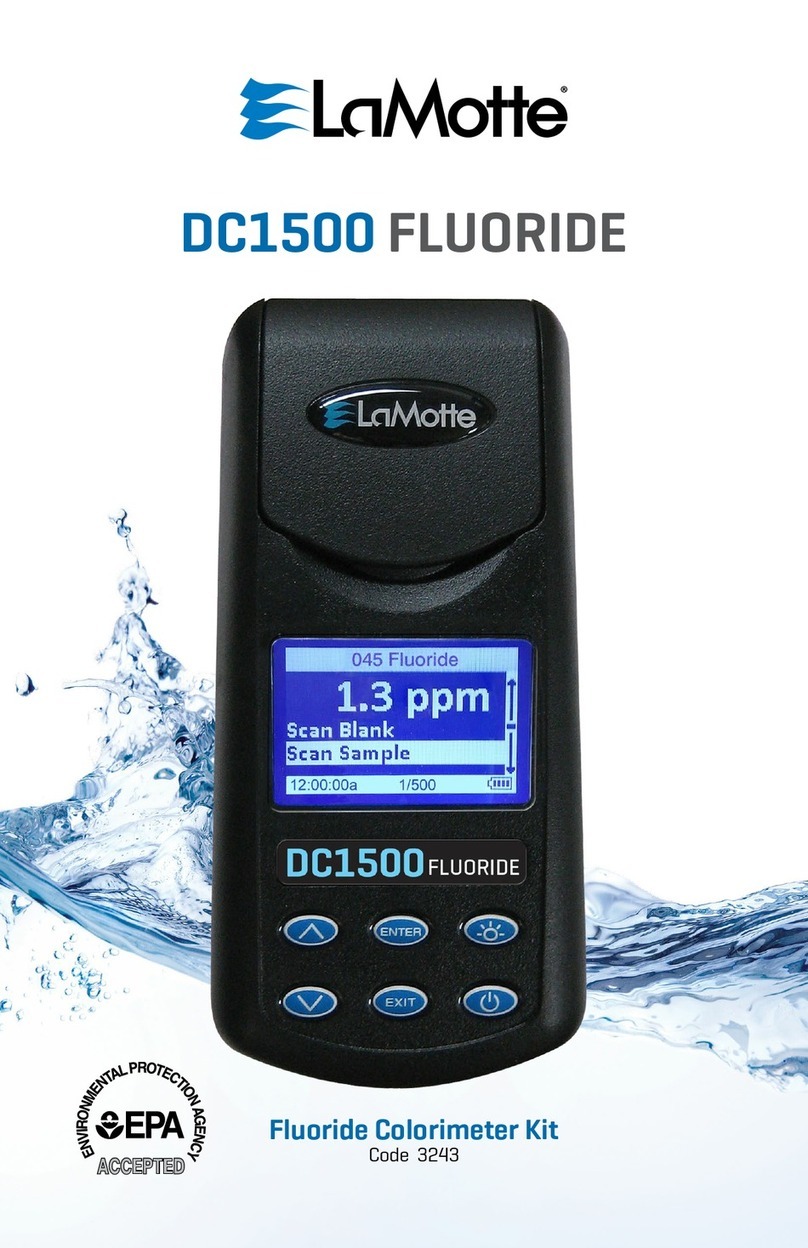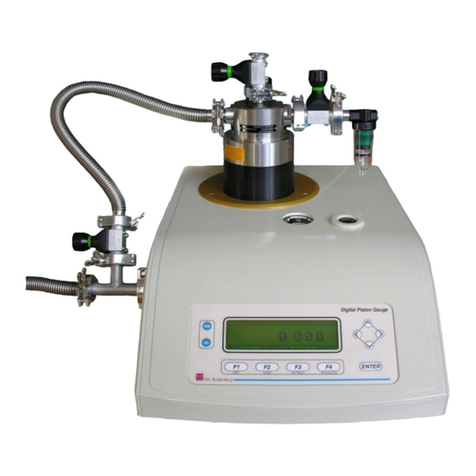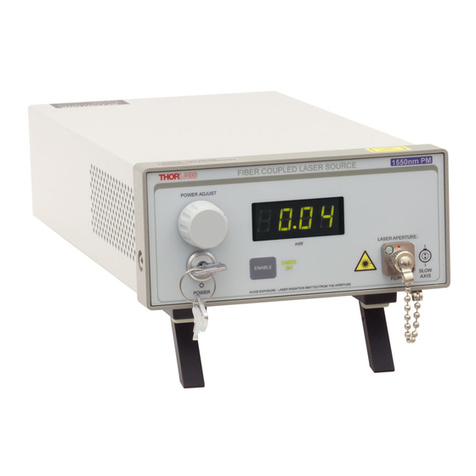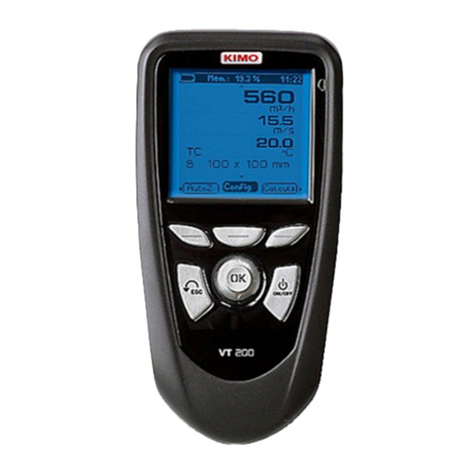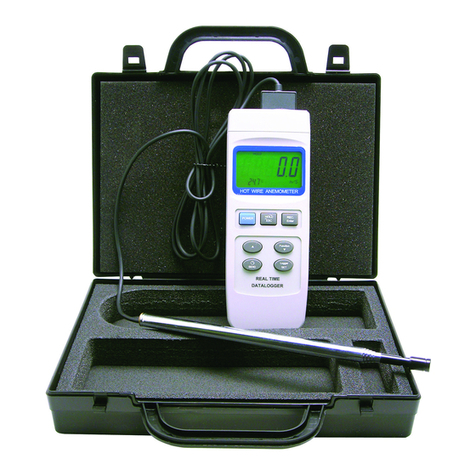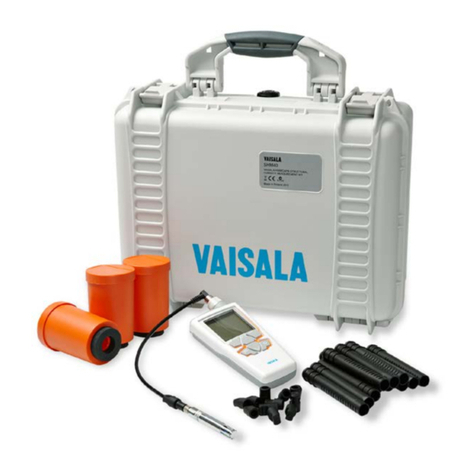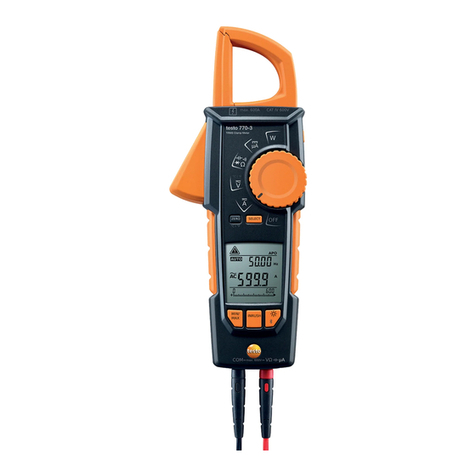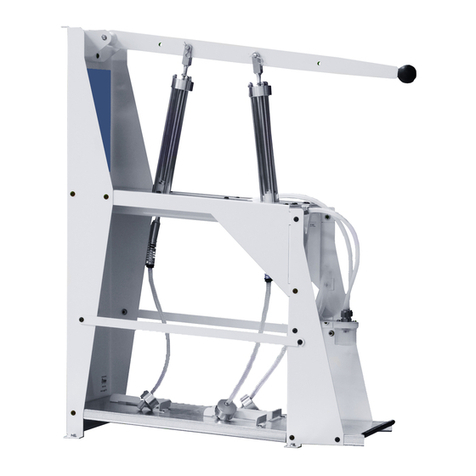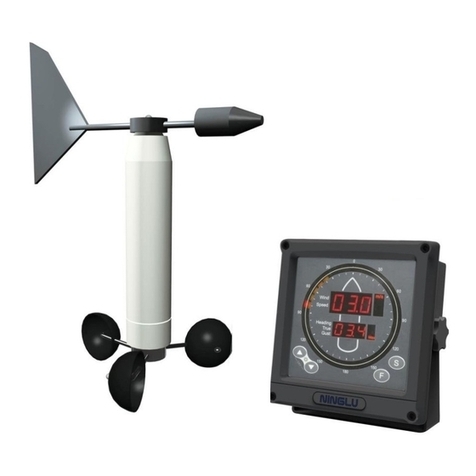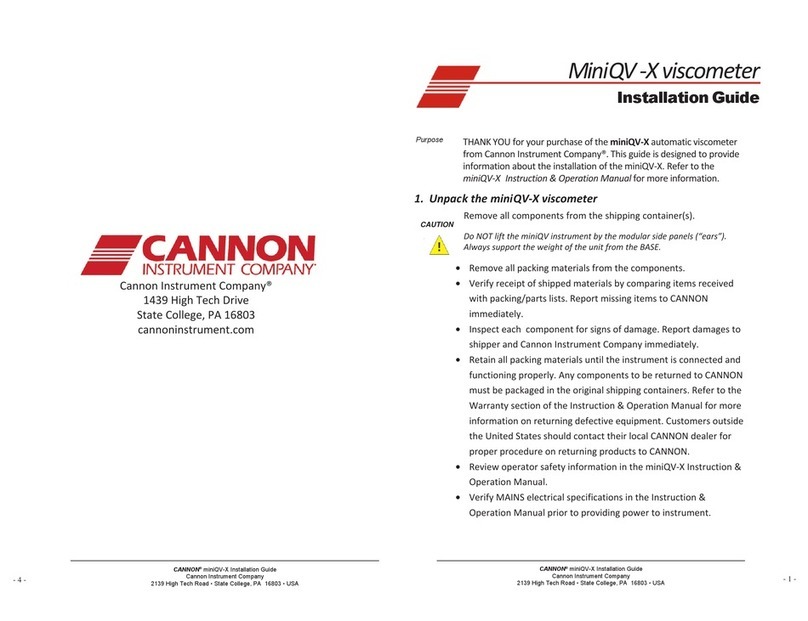ThermoProbe TP7-D User manual

Thermoprobe Models TP7D and TP9A
English | Sp
TP7-D
TP9-A
U
SER
M
ANUAL
Thermoprobe Models TP7D and TP9A
English | Sp
anish | French | Russian | Chinese
ANUAL

EUDeclarationofConformityaccordingtodirective2014/34/EU(ATEX)
Thermoprobe,Inc.herebydeclarestheTP7‐DandTP9‐Aproductstobeinaccordancewiththefollowingstandards
anddirectives:
NameandaddressofManufacturerThermoProbe,Inc.
112AJetportDr.
Pearl,MS39208USA
DescriptionofDevices TP7‐DandTP9‐A
PortableElectronicThermometers
Ex-Designation II 1 G Ex ia IIB T4 Ga
EC‐TypeExaminationCertificate ITS17ATEX201515X
NotifiedBodyIntertekTesting&CertificationLimited
IntertekHouse
CleeveRoad
Leatherhead,
SurreyKT227SB,UK
Auditingbody(QAN) IntertekTesting&CertificationLimited
IntertekHouse
CleeveRoad
Leatherhead,
SurreyKT227SB,UK
IdentificationNumber:0359
AppliedHarmonizedStandards
EN60079‐0:2012+A112013 Explosiveatmospheres–Part0:Equipment–Generalrequirements
EN60079‐11:2012ExplosiveAtmospheres–Part11:EquipmentProtectionbyIntrinsic
Safety‘i’
AppliedEuropeanDirectives
2014/34/EU‐Equipmentandprotectivesystemsintendedforuseinpotentiallyexplosiveatmospheres
ThermoProbe,Inc.
LukeBartkiewicz
President
10/10/2017,JK

USER INSTRUCTIONS - TP7-D & TP9-A
INTRODUCTION
This manual describes the basic function, use and safety instructions for a model TP7-D and TP9-A portable digital
thermometer instrument.
REPLACING BATTERY
When the battery voltage is low, the low battery icon will show on the display.
When the battery voltage is very low, the backlight will no longer operate and the low battery icon will ‘blink’ on the
display.
Replace batteries as soon as possible in a safe location after the low battery is noticed. This will ensure backlight
operation, and avoid possible malfunctioning. Do not attempt to calibrate the instrument if the low battery indicator is
displayed.
WARNING:
Batteries must be changed in Non-hazardous area.
Batteries must be of correct approved type.
Batteries must be installed with correct polarity making sure the (+) end of the battery is aligned with (+)
symbol embossed in the battery case.
Batteries must not be installed with polarity reversed where one cell could charge another cell.
New batteries must not be mixed with old batteries. Batteries must not be mixed with batteries of other
models or manufacturers.
a) Ensure the instrument is in a non-hazardous area & powered off.
b) Use a #2 Phillips drive to remove the 3 screws holding the front cover on the TP7-D or the 2 screws holding the
front cover on the TP9-A.
c) Use a #1 Phillips drive to remove the single screw from the battery cover. Remove the battery cover, push one
battery towards the spring contact and lift battery up from the holder, and then remove the remaining battery.
d) Install each new battery making sure the (+) end of the battery is aligned with (+) symbol embossed in the battery
case.
e) Replace the retaining device and reinstall the cover.
CERTIFIED Batteries for the TP9-A and TP7-D are as follows:
Manufacturer Type Part Number
Duracell AA (LR6) Alkaline MN1500
Panasonic AA (LR6) Alkaline LR6XWA
GP (Gold Peak) AA (LR6) Alkaline GP15A
AUTHORIZED REPAIR
It is recommended that service beyond the scope of this manual be performed by ThermoProbe, Inc. or one of its
authorized distributors.
See www.thermoprobe.net for video on proper use of this instrument. Refer to American Petroleum Institute
measurement standard Chapter 7.2.
10/2017, JK

USER INTERFACE
Up/Down Menu Buttons
Up/Down Menu Buttons Icons for Memory
readin
g
s
Indicators for
calibration points
Temperature
indicating arrows
Low batter
y
indicato
r
Power/Select Button
Power Button:
Pressing the Power button once will turn on the device. (Note: The instrument will automatically power off 20 minutes
after the last button push.) Pressing and holding the “Power” button until it displays ‘OFF’ will turn off the instrument.
Selection MENU:
Use the “Up/Down” Menu buttons for the following selections:
LOG:Saves current stable temperature up to 4 readings
C-F: Select Celsius or Fahrenheit temperature display
DECIMAL: Select 0.1 or 0.01 display resolution
MEMORY - Use “up/down” buttons to display:
Lowest reading
Average reading
Highest reading
Saved (Logged) readings 1-10
(Use CLR LOG to erase saved readings)
CALIBRAT: Enter calibration/adjustment mode
(Requires 3 digit password: 112) - See Calibration Procedure
10/2017, JK

Backlight
When the instrument is operating in low-light conditions a photocell will detect this situation and turn the backlight
on.
Temperature Logging
It is necessary for the temperature to be stable before logging temperature. The display arrows will flash 3 times when
the temperature reading has stabilized.
If you wish to log the temperature, Press the “down” button once until LOG is displayed. Press the “Select” button
once to save a reading. An acknowledgment of a saved reading will occur with a display of “LOG 1-10”. This can be
repeated for up to 10 saved readings.
The logged temperatures can be accessed from the MEMORY menu. Logged temperatures will display with the LOG
icon and a prefix (1,2,3,4,5,6,7,8,9,0) corresponding to the previously logged readings. The up/down buttons can be
used to advance through the readings. Select EXIT to return to the temperature display.
Logged readings will be retained even after the unit is powered off. Logged readings can be cleared by going to the
Memory section of the Menu and selecting CLR LOG. New readings cannot be taken until the readings are cleared.
USB Memory
A micro-usb connection is available on the circuit board allowing access to calibration & logged data.
Warning: Do not access the circuit board in a hazardous location.
Lowest, Highest & Average readings
The lowest, highest and average readings can be accessed through the MEMORY menu. The readings are indicated
by the LOW, AVG or HIGH icons on the display. These readings are not related to the logged readings, but are
determined from the temperature when the unit is powered on. These readings are deleted after the unit is powered
off.
Display Codes
OPEN CKT - Indicates the sensor is operating above its temperature limit, the Probe Assembly is open circuited
from a cut or broken section, or the cable is not properly inserted at the circuit board terminal. The most common cause
is a damaged cable.
SHORT CKT - Indicates the sensor is operating below its temperature limit or the Probe Assembly is short circuited
due to a smashed or cut section. The most common cause is a damaged cable.
NONE – There are no logged readings saved in memory.
2 WIRE – A 2 wire probe connection has been detected.
3 WIRE – A 3 wire probe connection has been detected.
NO CAL – The device does not have stored calibration data for the temperature probe. Perform an
adjustment/calibration before use.
10/2017, JK

Probe Types
The TP7-D or TP9-A can use either 2-wire or 3-wire probe assemblies.
ThermoProbe replacement probe assemblies are available in different configurations. The cable length is available in
lengths up to 50 meters or 165 feet. Standard brass markings are available applied in 5 feet or 1 meter increments. The
sensors are available with 4 weight types. The probe assembly part configurations are as follows:
REPLACING THE PROBE ASSEMBLY
NOTES:
1) Replacement of the probe assembly requires re-calibration of the device. Replacement should only be
done by experienced personnel and if calibration equipment is available.
2) Please refer to IEC/EN 60079-19 (Explosive atmospheres - Part 19: Equipment repair, overhaul and
reclamation) when making the repair.
3) Only use replacement probe assemblies obtained from ThermoProbe, Inc. or one of its authorized
distributors.
a) First follow REPLACING BATTERY instructions a through c to remove batteries.
b) On the circuit board push the terminals clamps down and remove the wires noting the wire lead color code
arrangement. See Figure 1.
White – positive sensor wire
Green – cable compensating wire (not used on 2 wire models)
Silver – negative sensor wire & shield wire
c) Set the cover and circuit board aside and remove the strain relief knot in cable assembly.
d) Unwrap the cable from the assembly and pull the cable free of the rubber grommet.
e) Insert the new cable wire through the rubber grommet and then pull several inches of cable past the grommet.
f) Tie a simple overhand knot in the cable at the grommet for strain relief and pull the knot up to the grommet.
g) On the circuit board, push the terminal clamp levers down and insert the new wire leads according to the terminal
color codes. The label indicates how to connect a 2 wire probe vs. a 3 wire probe (includes green wire). See Figure 1.
h) Reinstall the batteries and cover and re-spool the cable assembly.
i) Perform a calibration (see calibration procedure).
Figure 1: Probe Assembly Lead Attachment
10/2017, JK

CALIBRATION PROCEDURE
The calibration mode should only be accessed by qualified personnel with proper equipment; otherwise
calibration integrity may be compromised. Read the following instructions carefully.
At least 2 points are required to make an adjustment. (2-Point calibration). Additional points can be taken
(3-Point or 4-Point calibration) to calibrate a large range of temperatures (e.g. 0°F to 300°F) or if you want
to match specific points in your range. You should include points at the bottom and top of the range. You
must have the proper equipment for every point of calibration.
Do not attempt to calibrate the instrument if the low battery indicator has been displayed since the new
calibration values may not be properly stored to memory.
Refer to API 7.2 or another recognized standard for routine calibration verification recommendations.
Calibration must not be performed in any environment considered to be hazardous.
Equipment needed:
Ice Bath or other low temperature bath with reference thermometer.
Warm to hot fluid bath between 20°C (approx 68°F), or higher up to 90°C (approx 194°F) with reference
thermometer. (see Note)*
Optional high temperature oil bath at about 150°C/300°F and reference thermometer.
*Note for limited calibration: If entire range capability of instrument is not required, the 2 point high adjustment
can be made at a temperature relatively close to the common temperature of the liquid measured and accuracy
will be maintained within the limited range. For example: If liquid product to be measured is commonly less than
38°C (approx. 100°F), then a “high point” calibration can be made near that temperature. Temperature accuracy
above this calibration point cannot be assured.
To calibrate proceed with the following steps:
1. Enter calibration mode by going to CALIBRAT in the selection Menu. When this is selected, the user will be
prompted to enter a 3 digit password. Using the “up/down” buttons allows each digit to be adjusted. Once the
correct value is set, advance to the next digit by pressing the “select” button. After the 3rd digit is set press the
“select” button to enter Calibration mode. If an incorrect password is entered, FAIL will display and the unit
will return to temperature mode. Once in Calibration mode the ‘CAL’ icon on the display will blink. The
calibration mode password is: 112
2. Select ADJUSTfrom the calibration menu and then select the desired number of calibration points. Pick
2PT CAL, 3PT CAL or 4PT CAL using the select button.
NOTE: If the user is not ready to enter the calibration mode, the EXIT option can be chosen.
10/2017, JK

3. The device is now in adjustment mode. The display will show ADD PT1. The “up/down” buttons can be used
to select a different point to adjust or CANCEL. If the CANCEL option is chosen then the calibration
procedure is exited and the prior calibration values are re-activated.
ADD PT1 = Lowest temperature point
ADD PT2 = the next higher temperature point
ADD PT3 = the next higher temperature point (only used in 3-point calibration or 4-point calibration mode)
ADD PT4 = the highest temperature point (only used in 4-point calibration mode)
ADJ DONE = Save and exit calibration mode (all points adjusted & valid)
CANCEL = Exit calibration mode without saving
Pick which point to adjust and press the select button to begin. The current temperature will display and the
CAL icon and the number of the point to adjust will now be blinking.
NOTES:
oCalibration can be performed to hundredths of a degree.
oThe up/down buttons can be used to increase or decrease the display reading.
oHolding the up/down buttons adjusts 0.1 degrees increments.
oMomentary Presses of the up/down buttons for less than 0.5 seconds adjusts 0.01 degrees for every
press.
oThe display arrows will flash 3 times when the temperature reading has stabilized.
oAll points must be saved before selecting ADJ DONE. A DATA ERR message will display if all
points have not been saved or are not in increasing temperatures. (Ex: PT1 = 32F, PT2 = 120F, PT3
= 250F)
oWhile in calibration mode the temperature will display based on the prior calibration curve.
oThe RESETCAL feature can be used to return the unit to a factory calibration curve.
(calibration/adjustment will still be required).
oThe RESETCAL (reset to factory calibration) feature should be used if the probe is replaced using
a 2-wire assembly instead of a 3-wire assembly or if prior calibration has caused the unit to read
excessively out of tolerance.
4. Once the temperature has stabilized, using a reference device check the actual temperature in the bath and use
the “up/down” buttons to adjust the device to the actual temperature. Once the device temperature matches the
actual temperature, press the select button to save the setting. The display will show SAVE or EXIT. If
EXIT is selected it will return to the ADD PT1 menu. Once SAVE is selected the display will advance to the
next temperature point for adjustment showing ADD PT…. The up/down buttons can be used to select a
different point to adjust or CANCEL. If the CANCEL option is chosen then the calibration procedure is exited
and the prior calibration values are re-activated.
oNOTE: Once SAVE is selected the temperature display will return to the previous reading until the
calibration is completed.
oNOTE: If SAVE is selected before the temperature has stabilized, the display will show NOT
STABLE. Wait for the temperature to stabilize before saving.
5. Move the probe to the next bath and repeat step 4. After you save the highest temperature point the display
will flash READY and the new calibration settings will be in effect. The buttons will now resume their
normal operating functions. The calibration settings are saved to flash memory when the device is turned off.
The unit will not turn off automatically. Manually turning the unit off saves the calibration data.
ThermoProbe, Inc.
112A JETPORT DR.
PEARL, MS 39208
Tel: +1 601.939.1831
Fax: +1 601.355.1831
www.thermoprobe.net
10/2017, JK

10/2017, JK
SAFETY INSTRUCTIONS - TP7-D & TP9-A REV 102017
These ThermoProbe instruments are intended for use in both hazardous (potentially flammable or explosive) and non-
hazardous areas under dry conditions at ambient temperatures between -20 to 40°C.
The instruments are not intended for use in permanent outdoor installations and are not intended or tested for icing
conditions. Additional means of protection should be used where the equipment may be exposed to excessive external
stresses (e.g. vibration, heat, impact, etc.). The user must have a working knowledge of appropriate safety
requirements.
a) The user must have a thorough knowledge of the products to be measured and must know of the safety precautions
to be taken when working with the material to be measured.
b) The instrument shall be checked concerning severe defects; check that instrument is complete (including
grounding/bonding cable), has good batteries, etc. If necessary, check measurement accuracy. If any defects are
found, the instrument should not be used until repairs have been made.
c) The instrument, especially cable and probe, should be clean for safety and ease of use.
d) The physical measurement location should be evaluated for primary and secondary risks.
e) Power source must be removed before performing any maintenance.
f) Exchange of components other than the batteries may compromise ATEX/IECEx or other certifications and shall
only be undertaken by ThermoProbe or one of its qualified service providers. See also “Authorized Repair” section.
g) To reduce the risk of fire or explosion, this device must be bonded to the vessel according to clause 6.3.2 e),
IEC/EN 60079-14 before and during introduction into the vessel and shall remain bonded until the sensor probe is
completely withdrawn from the vessel.
h) The device must remain bonded to ground/earth using the provided connection whenever a hazardous atmosphere
could be present as well as during situations where electrostatic charging can occur such as the unwinding/winding of
the thermometer cable or filling or emptying of the tank.
CAUTION: In the event that any part of the instrument should become electrostatically charged in a potentially
hazardous location, follow company policies for testing and clearing the area of any hazardous gases before
attempting to bond the instrument to earth ground. If this is not possible allow sufficient time for the instrument to
naturally dissipate any charges before attempting to bond to earth ground. Given the atmosphere, this could take
several hours.
GUIDANCE NOTE
Problems with aggressive substances and environments: Be aware of aggressive substances and that extra protection
may be needed.
Caustic soda, highly basic and acidic substances will erode aluminum and copper ground clip and wire. The Sensor-
Cable assembly has external surfaces of stainless steel and fluoropolymer material. Exposure to Excessive heat can
melt the plastic components of the instrument.

10/2017, JK
SAFETY APPROVALS FOR TP7-D AND TP9-A:
AExiaIIBT4Ga
Applicable Standards are: Agency or Safety Designation
IEC 60079-0:Ed 6, IEC 60079-11:Ed 6 IECEx
EN 60079-0:2012 + A11 3013, EN60079-11:2012 Europe: ATEX
INTRINSIC SAFETY
Intrinsically safe equipment is defined as "equipment and wiring which is incapable of releasing sufficient electrical
or thermal energy under normal or abnormal conditions to cause ignition of a specific hazardous atmospheric mixture
in its most easily ignited concentration." (ISA-RP12.6) This is achieved by limiting the amount of power available to
the electrical equipment in the hazardous area to a level below that which will ignite the gases.
In order to have a fire or explosion, fuel, oxygen and a source of ignition must be present. An intrinsically safe system
assumes the fuel and oxygen is present in the atmosphere, but the system is designed so the electrical energy or
thermal energy of a particular instrument loop can never be great enough to cause ignition.
BATTERIES
WARNING:
Batteries must be changed in Non-hazardous area.
Batteries must be of correct approved type.
Batteries must be installed with correct polarity making sure the (+) end of the battery is aligned with (+)
symbol embossed in the battery case.
New batteries must not be mixed with old batteries.
Batteries must not be mixed with batteries of other models or manufacturers.
Batteries must not be installed with polarity reversed where one cell could charge another cell.
CERTIFIED Batteries for the TP9-A and TP7-D are as follows:
Manufacturer Type Part Number
Duracell AA (LR6) Alkaline MN1500
Panasonic AA (LR6) Alkaline LR6XWA
GP (Gold Peak) AA (LR6) Alkaline GP15A

INSTRUCCIONES PARA EL USUARIO - TP7-D Y TP9-A
INTRODUCCIÓN
Este manual describe las instrucciones básicas de funcionamiento, uso y seguridad, para los modelos de instrumento
de termómetro digital portátil TP7-D y TP9-A.
CAMBIO DE LA BATERÍA
Cuando la batería está baja, en la pantalla aparece el ícono de batería baja.
Cuando la batería está muybaja, la retroiluminación ya no funciona y el ícono de batería baja "parpadea" en la
pantalla.
Al reconocer que la carga de las baterías está baja, cámbielas tan pronto como sea posible y en un lugar seguro. Esto
garantiza el funcionamiento de la retroiluminación y evita el posible mal funcionamiento. No intente calibrar el
instrumento si el indicador de batería baja está encendido.
ADVERTENCIA:
Se deben cambiar las baterías en un área sin riesgos.
Las baterías deben ser del tipo aprobado correcto.
Se deben instalar las baterías con la polaridad correcta, asegurándose de que el lado (+) de la batería esté
alineado con el símbolo (+) realzado en el espacio de la batería.
No se deben instalar las baterías con la polaridad invertida, donde una celda podría cargar otra celda
equivocada.
No se deben mezclar baterías nuevas con baterías viejas. No se deben mezclar las baterías de diferentes
modelos o fabricantes.
a) Asegúrese de que el instrumento esté en un área no peligrosa y que esté apagado.
b) Utilice un desatornillador Phillips n.º 2 para retirar los 3 tornillos que sostienen la tapa delantera en el TP7-D o
los 2 tornillos que sostienen la tapa delantera en el TP9-A.
c) Utilice un desatornillador Phillips n.º 1 para retirar el tornillo de la cubierta de la batería. Retire la cubierta de la
batería, empuje una batería hacia el contacto de resorte y saque la batería del espacio, luego retire la batería restante.
d) Instale cada batería nueva asegurándose de que el lado (+) de la batería esté alineado con el símbolo (+) realzado
en el espacio de la batería.
e) Vuelva a colocar el dispositivo de retención y reinstale la cubierta.
Las baterías CERTIFICADAS para el TP9-A y para el TP7-D son las siguientes:
Fabricante Tipo Número de parte
Duracell AA (LR6) Alcalina MN1500
Panasonic AA (LR6) Alcalina LR6XWA
GP (Gold Peak) AA (LR6) Alcalina GP15A
REPARACIÓN AUTORIZADA
Se recomienda que el mantenimiento que no esté incluido en el ámbito de este manual sea llevado a cabo por
ThermoProbe, Inc. o por uno de sus distribuidores autorizados.
10/2017, JK

Vea en www.thermoprobe.net un video sobre el uso adecuado de este instrumento. Consulte el Capítulo 7.2 de la
norma de medición del Instituto Americano del Petróleo (American Petroleum Institute).
INTERFAZ DEL USUARIO
Botones Arriba/Aba
j
o
Botones Arriba/Aba
j
o Íconos para lecturas
de memoria
Indicadores de
puntos de
calibración
Flechas
indicadoras de
temperatura
Indicador de batería
Botón de Encendido/Selección
Botón de encendido:
Al presionar una vez el botón de Encendido se enciende el dispositivo. (Nota: El instrumento se apaga
automáticamente 20 minutos después de la última presión en el botón). Al presionar y sostener el botón “Power”
hasta que la unidad muestra "OFF", se apaga el instrumento.
10/2017, JK

MENÚ de selección:
Utilice los botones de menú “Arriba/Abajo” para las siguientes selecciones:
LOG: Guarda la temperatura estable actual por hasta 4 lecturas.
C-F: Selecciona grados Celsius o Fahrenheit para la temperatura que aparecerá en pantalla.
DECIMAL: Selecciona la resolución de 0.1 o 0.01 para la pantalla.
MEMORY - Utilice los botones “Arriba/Abajo” para mostrar:
Lectura más baja
Lectura promedio
Lectura más alta
Lecturas guardadas (Logged) 1-10
(Use CLR LOG para eliminar las lecturas guardadas)
CALIBRAT: Ingresa al modo de calibración/ajuste
(Requiere una contraseña de 3 dígitos: 112) - Consultar el Procedimiento de calibración
Retroiluminación
Cuando el instrumento opera en condiciones de baja iluminación, una fotocelda detecta la situación y enciende la
retroiluminación.
Registro de temperatura
Es necesario que la temperatura esté estable antes de registrarla. La flechas de la pantalla parpadean 3 veces cuando
la lectura de la temperatura se estabiliza.
Si desea registrar la temperatura, presione el botón “down” hasta que aparezca LOG. Presione el botón “Select”
una vez para guardar una lectura. Se presenta una confirmación de la lectura guardada mostrando “LOG 1-10”. Se
puede repetir esto para guardar hasta 10 lecturas.
Se puede acceder a las temperaturas guardadas desde el menú MEMORY. Las temperaturas guardadas se muestran
con el ícono LOG y un prefijo (1, 2, 3, 4, 5, 6, 7, 8, 9, 0) correspondiente a las lecturas guardadas previamente. Se
pueden usar los botones arriba/abajo para desplazarse entre las lecturas. Seleccione EXIT para regresar a la pantalla
de temperatura.
10/2017, JK

Las lecturas guardadas se conservan incluso después de apagar la unidad. Se pueden eliminar las lecturas guardadas
al ingresar a la sección Memory y seleccionar CLR LOG. No se pueden tomar nuevas lecturas hasta que se
eliminan las lecturas.
Memoria USB
Hay una conexión micro-USB disponible en la tarjeta del circuito que permite acceder a la calibración y los datos
guardados.
Advertencia: No acceda a la tarjeta del circuito en un área peligrosa.
Lecturas mínima, máxima y promedio
Se puede acceder a las lecturas mínima, máxima y promedio a través del menú MEMORY. Las lecturas tienen una
indicación de ícono LOW (mínima), AVG (promedio) o HIGH (máxima) en la pantalla. Estas lecturas no están
relacionadas con las lecturas guardadas, se determinan a partir de la temperatura cuando se enciende la unidad.
Dichas lecturas se borran cuando se apaga la unidad.
Códigos de pantalla
OPEN CKT - Indica que el sensor está funcionando por encima de su límite de temperatura, se abre el circuito del
Ensamble del sensor de una sección cortada o rota o el cable no está insertado adecuadamente en la terminal de la
tarjeta de circuito. La causa más común es un cable dañado.
SHORT CKT - Indica que el sensor está funcionando por debajo de su límite de temperatura o que el Ensamble del
sensor está en cortocircuito debido a una sección rota o cortada. La causa más común es un cable dañado.
NONE – No hay lecturas guardadas en la memoria.
2 WIRE – Se detectó la conexión de una sonda de 2 cables.
3 WIRE – Se detectó la conexión de una sonda de 3 cables.
NO CAL – El dispositivo no tiene datos de calibración almacenados para la sonda de temperatura. Realice un
ajuste/una calibración antes del uso.
Tipos de sonda
El TP7-D o el TP9-A pueden utilizar ensambles de sonda de 2 o de 3 cables.
Los ensambles de sonda de reemplazo ThermoProbe están disponibles en diferentes configuraciones. Hay cables
disponibles en longitudes de hasta 50 metros o 165 pies. Hay marcas estándar de latón disponibles aplicadas en
incrementos de 5 pies o 1 metro. Los sensores están disponibles en 4 pesos diferentes. Las configuraciones de la
pieza del ensamble de sonda son las siguientes:
10/2017, JK

REEMPLAZO DEL ENSAMBLE DE SONDA
NOTAS:
1) El reemplazo del ensamble de sonda requiere de una nueva calibración del dispositivo. El remplazo solo
debe hacerlo personal experimentado y solo si hay equipo de calibración disponible.
2) Consulte IEC/EN 60079-19 (Atmósferas explosivas - Parte 19: Reparación transformación o
recuperación de un equipo) al hacer la reparación.
3) Utilice únicamente ensambles de sonda de reemplazo obtenidos de ThermoProbe, Inc. o de uno de sus
distribuidores autorizados.
a) Siga primero las instrucciones de REEMPLAZO DE BATERÍA a hasta c para retirar las baterías.
b) En la tarjeta del circuito presione las abrazaderas de las terminales hacia abajo y retire los cables teniendo en
cuenta el arreglo por colores de las terminales de los cables conductores. Vea la Figura 1.
Blanco – cable positivo del sensor
Verde – cable de compensación (no usado en modelos de 2 cables)
Plateado – cable negativo del sensor y con blindaje
c) Coloque aparte la cubierta y la tarjeta de circuito y deshaga el nudo de alivio de tensión en el ensamble del cable.
d) Desenrolle el cable del ensamble y jale el cable para liberarlo del ojal de hule.
e) Inserte el nuevo cable a través del ojal de hule y luego jálelo varias pulgadas más allá del ojal.
f) Haga un nudo simple en el cable a la altura del ojal como alivio de tensión y jale el nudo contra el ojal.
g) Presione hacia abajo las palancas de las abrazaderas de las terminales e inserte las nuevas terminales de acuerdo
con el código de colores. La etiqueta indica la manera de conectar la sonda de 2 cables o la sonda de 3 cables
(incluye cable verde). Vea la Figura 1.
h) Vuelva a instalar las baterías y la cubierta y enrolle el ensamble del cable.
i) Realice una calibración (consulte el procedimiento de calibración).
Figura 1: Sujeción del cable del ensamble de sonda
PROCEDIMIENTO DE CALIBRACIÓN
Únicamente personal calificado y con el equipo adecuado debe acceder al modo de calibración, de otra
forma puede verse comprometida la integridad de la calibración. Lea cuidadosamente las siguientes
instrucciones.
Se requieren por lo menos 2 puntos para hacer un ajuste. (Calibración de 2 puntos). Se pueden tomar
puntos adicionales (calibración de 3 o 4 puntos) para calibrar un rango amplio de temperaturas (p.ej. 0 °F a
300 °F) o si se desea hacer coincidir puntos específicos en el rango. Se deben incluir puntos en la parte
inferior y en la parte superior del rango. Se debe contar con el equipo adecuado para cada punto de
calibración.
No intente calibrar el instrumento si el indicador de batería baja está encendido, ya que los valores de la
nueva calibración pueden no ser guardados adecuadamente en la memoria.
10/2017, JK

Consulte API 7.2 o cualquier otra norma reconocida para obtener recomendaciones sobre la verificación
rutinaria de calibración.
No se debe realizar la calibración en un entorno considerado peligroso.
Equipo necesario:
Baño de hielo u otro baño de baja temperatura con un termómetro de referencia.
Baño de fluido tibio o caliente entre 20 °C (aprox. 68 °F), o más, hasta 90 °C (aprox. 194 °F) con
termómetro de referencia (ver la Nota)*.
Baño opcional de aceite a alta temperatura a aproximadamente 150 °C/300 °F y termómetro de referencia.
*Nota para calibración limitada: Si no se requiere toda la capacidad del rango del instrumento, se puede realizar
el ajuste de 2 puntos altos a una temperatura relativamente cercana a la temperatura común del líquido medido y
la precisión se mantendrá dentro del rango limitado. Por ejemplo: Si el producto líquido a medir está , por lo
general, a menos de 38 °C (aprox. 100 °F), entonces se puede hacer una calibración de “punto alto” en el
entorno de esa temperatura. No se puede asegurar la precisión de la temperatura por encima de este punto de
calibración.
Siga los pasos siguientes para la calibración:
1. Ingrese al modo de calibración en CALIBRAT, en el Menú de selección. Cuando se selecciona esto, se le
pide al usuario que ingrese una contraseña de 3 dígitos. El uso de los botones “arriba/abajo” permite ajustar
cada dígito. Una vez establecido el valor correcto, avance al siguiente dígito presionando el botón “select”.
Después de ingresar el 3er dígito, presione el botón “select” para ingresar al modo de Calibración. Si se
ingresa una contraseña incorrecta, se muestra FAIL y la unidad vuelve al modo de temperatura. Una vez en
el modo de Calibración, parpadea el ícono "CAL" en la pantalla. La contraseña para el modo de
calibración es: 112
2. Seleccione ADJUST en el menú de calibración y luego seleccione la cantidad deseada de puntos de
calibración. Seleccione 2PT CAL, 3PT CAL o 4PT CAL utilizando el botón de selección.
NOTA: Si el usuario no está listo para ingresar al modo de calibración, se puede elegir la opción
EXIT (Salir).
3. El dispositivo está ahora en el modo de ajuste. La pantalla muestra ADD PT1. Se pueden usar los botones
“arriba/abajo” para seleccionar un punto de ajuste diferente o CANCEL. Si se elige la opción CANCEL,
entonces se sale el procedimiento de calibración y se vuelven a activar los valores anteriores de calibración.
ADD PT1 = punto de temperatura mínima
ADD PT2 = el siguiente punto de temperatura más alta
10/2017, JK

ADD PT3 = el siguiente punto de temperatura más alta (se usa únicamente en el modo de calibración de 3
o 4 puntos)
ADD PT4 = el punto de temperatura más alta (se usa únicamente en el modo de calibración de 4 puntos)
ADJ DONE = Guardar y salir del modo de calibración (todos los puntos ajustados y válidos)
CANCEL = Salir del modo de calibración sin guardar
Seleccione el punto a ajustar y presione el botón "select" para iniciar. La temperatura actual se muestra y
parpadean el ícono CAL y el número del punto a ajustar.
NOTAS:
oLa calibración se puede llevar a cabo hasta a centésimos de grado.
oSe pueden utilizar los botones arriba/abajo para aumentar o disminuir la lectura de la pantalla.
oMantener presionados los botones arriba/abajo ajusta en incrementos de 0.1 grados.
oLa presión momentánea de los botones arriba/abajo por menos de 0.5 segundos ajusta 0.01
grados para cada presión.
oLa flechas de la pantalla parpadean 3 veces cuando la lectura de la temperatura se estabiliza.
oSe deben guardar todos los puntos antes de seleccionar ADJ DONE.Se muestra un mensaje
DATA ERR si no se han guardado todos los puntos o no están en temperaturas crecientes. (P. ej.:
PT1 = 32 °F, PT2 = 120 °F, PT3 = 250 °F)
oMientras se está en el modo de calibración, se muestra la temperatura con base en la curva anterior
de calibración.
oSe puede usar la función RESETCAL para regresar la unidad a una curva de calibración de
fábrica. (de todos modos será necesaria una calibración o un ajuste).
oSe debe utilizar la función RESETCAL (restablecer la calibración de fábrica) si se cambia la
sonda usando un ensamble de 2 cables en lugar de un ensamble de 3 cables o si la calibración
anterior provoca que la unidad lea excesivamente fuera de la tolerancia.
4. Cuando se estabiliza la temperatura, verificar con un dispositivo de referencia la temperatura actual en el
baño y utilizar los botones “arriba/abajo” para ajustar el dispositivo a la temperatura real. Cuando la
temperatura en el dispositivo coincida con la temperatura real, presione el botón de selección para
guardar la configuración. La pantalla muestra SAVE o EXIT. Si se selecciona EXIT se vuelve al menú
ADD PT1. Cuando se selecciona SAVE la pantalla pasa al siguiente punto de temperatura a ajustar,
mostrando ADD PT….Se pueden utilizar los botones arriba/abajo para seleccionar un punto diferente a
ajustar o CANCEL. Si se elige la opción CANCEL, entonces se sale el procedimiento de calibración y se
vuelven a activar los valores anteriores de calibración.
oNOTA: Cuando se selecciona SAVE la pantalla de temperatura regresa a la lectura anterior hasta
finalizar la calibración.
oNOTA: Si se selecciona SAVE antes de que se estabilice la temperatura, la pantalla muestra NOT
STABLE. Espere a que se estabilice la temperatura antes de guardar.
5. Pase la sonda al siguiente baño y repita el paso 4. Después de guardar el punto de temperatura más alta, la
pantalla parpadea con el mensaje READY y la nueva calibración entra en efecto. Los botones retoman sus
funciones normales de operación. La calibración se guarda en la memoria flash cuando se apaga el
dispositivo. La unidad no se apaga automáticamente. Se guardan los datos de calibración al apagar
manualmente la unidad.
ThermoProbe, Inc.
112A JETPORT DR.
PEARL, MS 39208
Tel.: +1 601.939.1831
Fax: +1 601.355.1831
www.thermoprobe.net
10/2017, JK

INSTRUCCIONES DE SEGURIDAD - TP7-D Y TP9-A
REV. 10/2017
Estos instrumentos ThermoProbe son para su uso tanto en áreas peligrosas (potencialmente inflamables o
explosivas) como no peligrosas, en condiciones secas y a una temperatura ambiente de entre -20 y 40°C.
Los instrumentos no fueron diseñados para usarse en instalaciones permanentes al aire libre y no fueron diseñados ni
sometidos a prueba en condiciones de congelación. Se deben utilizar otros medios de protección cuando el equipo
pudiera quedar expuesto a excesivas exigencias externas (p. ej. vibración, calor, impacto, etc.). El usuario debe tener
conocimiento operativo de los requisitos de seguridad correspondientes.
a) El usuario debe tener un amplio conocimiento de los productos a medir y conocer las precauciones de seguridad a
tomar cuando se trabaja con el material a medir.
b) Se debe revisar el instrumento para detectar defectos graves; controle que el instrumento esté completo
(incluyendo el cable de tierra/unión), que tenga baterías en buenas condiciones, etc. Si fuera necesario, verifique la
precisión de las mediciones. Si se encontrara algún defecto, no se debe utilizar el instrumento hasta que se lleven a
cabo las reparaciones.
c) El instrumento, en especial el cable y la sonda, debe estar limpio por razones de seguridad y de facilidad de uso.
d) Se deben evaluar los riesgos primarios y secundarios de la ubicación física de la medición.
e) Se debe retirar la fuente de energía antes de realizar cualquier operación de mantenimiento.
f) El cambio de componentes que no sean las baterías puede comprometer las certificaciones ATEX/IECEx u otras y
debe llevarlo a cabo ThermoProbe o de uno de sus proveedores de servicio calificados. Consulte también la sección
“Reparación autorizada”.
g) Para reducir el riesgo de incendio o explosión, se debe unir este dispositivo al recipiente conforme a la cláusula
6.3.2 e), IEC/EN 60079-14 antes y durante la introducción al recipiente y debe permanecer unido hasta que la sonda
se retire completamente del recipiente.
h) El dispositivo debe permanecer unido a tierra física utilizando la conexión provista y siempre que pueda haber
presencia de una atmósfera peligrosa, así como en situaciones donde se pueda presentar descarga electrostática,
como alenrollar/desenrollar el cable del termómetro o llenar o vaciar el tanque.
PRECAUCIÓN: En caso de que cualquier parte del instrumento quedara cargada electrostáticamente en una
ubicación potencialmente peligrosa, siga las políticas de la empresa para probar y despejar cualquier gas peligroso
del área antes de intentar unir el instrumento a la tierra física. Si esto no fuera posible, debe dar tiempo suficiente
para que el dispositivo disipe de manera natural cualquier carga antes de unirlo a la tierra física. Según el tipo de
atmósfera, esto puede tardar varias horas.
NOTA DE ORIENTACIÓN
Problemas con sustancias y ambientes agresivos: Sea consciente de las sustancias agresivas y de la posible
necesidad de protección adicional.
La soda cáustica, y las sustancias de alto nivel básico o ácido corroen el broche y el cable de aluminio y cobre. El
ensamble de sensor y cable tiene superficies externas de acero inoxidable y un material fluoropolimérico. La
exposición a calor excesivo puede fundir los componentes plásticos del instrumento.
10/2017, JK

APROBACIONES DE SEGURIDAD DEL TP7-D Y DEL TP9-A:
AEx ia IIB T4 Ga
Las normas pertinentes son: Agencia o designación de seguridad
IEC 60079-0:Ed 6, IEC 60079-11:Ed 6 IECEx
EN 60079-0:2012 + A11 3013, EN60079-11:2012 Europa: ATEX
SEGURIDAD INTRÍNSECA
Se define al equipo intrínsecamente seguro como "equipo y cableado que no pueden liberar suficiente energía
térmica o eléctrica, ya sea bajo condiciones normales o anormales, como para provocar la ignición de una mezcla
atmosférica específica peligrosa en su concentración de mayor ignición" (ISA-RP12.6). Esto se logra al limitar la
cantidad de potencia disponible para el equipo eléctrico en el área peligrosa a un nivel inferior al necesario para que
se inflamen los gases.
Para que haya ignición o explosión, debe haber presencia de combustible, oxígeno y una fuente de ignición. Un
sistema intrínsecamente seguro asume que el combustible y el oxígeno están presentes en la atmósfera, pero el
sistema está diseñado de manera tal que la energía eléctrica o la energía térmica del circuito de un instrumento en
particular nunca sean suficientes para provocar la ignición.
BATERÍAS
ADVERTENCIA:
Se deben cambiar las baterías en un área sin riesgos.
Las baterías deben ser del tipo aprobado correcto.
Se deben instalar las baterías con la polaridad correcta, asegurándose de que el lado (+) de la batería esté
alineado con el símbolo (+) realzado en el espacio de la batería.
No se deben mezclar baterías nuevas con baterías viejas.
No se deben mezclar las baterías de diferentes modelos o fabricantes.
No se deben instalar las baterías con la polaridad invertida, donde una celda podría cargar otra celda
equivocada.
Las baterías CERTIFICADAS para el TP9-A y para el TP7-D son las siguientes:
Fabricante Tipo Número de parte
Duracell AA (LR6) Alcalina MN1500
Panasonic AA (LR6) Alcalina LR6XWA
GP (Gold Peak) AA (LR6) Alcalina GP15A
10/2017, JK

INSTRUCTIONS D'UTILISATION – TP7-D et TP9-A
INTRODUCTION
Ce manuel décrit le fonctionnement de base et les instructions d’utilisation et de sécurité du thermomètre numérique
portable modèle TP7-D ou TP9-A.
REMPLACER LES PILES
Lorsque la tension des piles est faible, l’icône de pile faible s'affiche sur l’écran.
Lorsque la tension des piles est très faible, le rétroéclairage ne fonctionne plus et l’icône de pile faible « clignote »
sur l’écran.
Remplacez les piles dès que possible dans un endroit sûr après avoir remarqué l’indicateur de pile faible. Cela vous
permettra d’utiliser le rétroéclairage et évitera un éventuel dysfonctionnement. N’essayez pas d’étalonner
l’instrument si l’indicateur de pile faible est affiché.
ATTENTION :
Les piles doivent être changées dans une zone sans risques.
Les piles doivent être du type correct approuvé.
Les piles doivent être mises en place avec la polarité correcte : assurez-vous que l’extrémité (+) de la
batterie est alignée avec le symbole (+) inscrit en relief sur le boîtier de la pile.
Les piles ne doivent pas être mises en place avec une polarité inversée qui ferait qu’une pile pourrait en
charger une autre.
Les nouvelles piles ne doivent pas être mélangées avec d’anciennes piles. Les piles ne doivent pas être
mélangées avec des piles d’autres modèles ou fabricants.
a) Vérifiez que l’instrument se trouve dans une zone sans risques et qu’il est éteint.
b) Utilisez un tournevis cruciforme Phillips numéro 2 pour retirer les 3 vis en maintenant le couvercle supérieur du
TP7-D ou les 2 vis en maintenant le couvercle supérieur du TP9-A.
c) Utilisez un tournevis Phillips numéro 1 pour retirer la vis unique du cache-piles. Retirez le cache-piles, poussez
une pile vers le contact à ressort et soulevez-la hors du compartiment, puis retirez la pile restante.
d) Installez chaque nouvelle pile en faisant en sorte que l’extrémité (+) de la pile soit alignée avec le symbole (+)
inscrit en relief sur le boîtier de la pile.
e) Replacer le cache et remettez en place le couvercle.
Les piles CERTIFIÉES pour le TP9-A et le TP7-D sont les suivantes :
Fabricant Type Référence
Duracell AA (LR6) alcaline MN1500
Panasonic AA (LR6) alcaline LR6XWA
GP (Gold Peak) AA (LR6) alcaline GP15A
RÉPARATIONS AUTORISÉES
Il est recommandé de faire appel à ThermoProbe, Inc. ou à l’un de ses distributeurs autorisés pour toutes les
interventions dépassant le cadre de ce manuel.
10/2017, JK
This manual suits for next models
3
Table of contents
Languages:
Other ThermoProbe Measuring Instrument manuals
Popular Measuring Instrument manuals by other brands
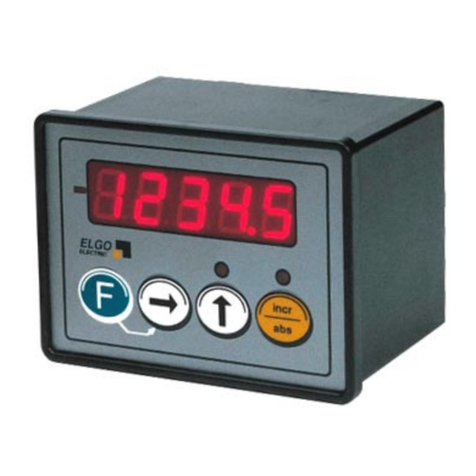
ELGO Electric
ELGO Electric Z54 Series manual

PCB Piezotronics
PCB Piezotronics IMI SENSORS M625B01 Installation and operating manual

Schiltknecht Messtechnik
Schiltknecht Messtechnik ThermoAir6/64 Operating instruction
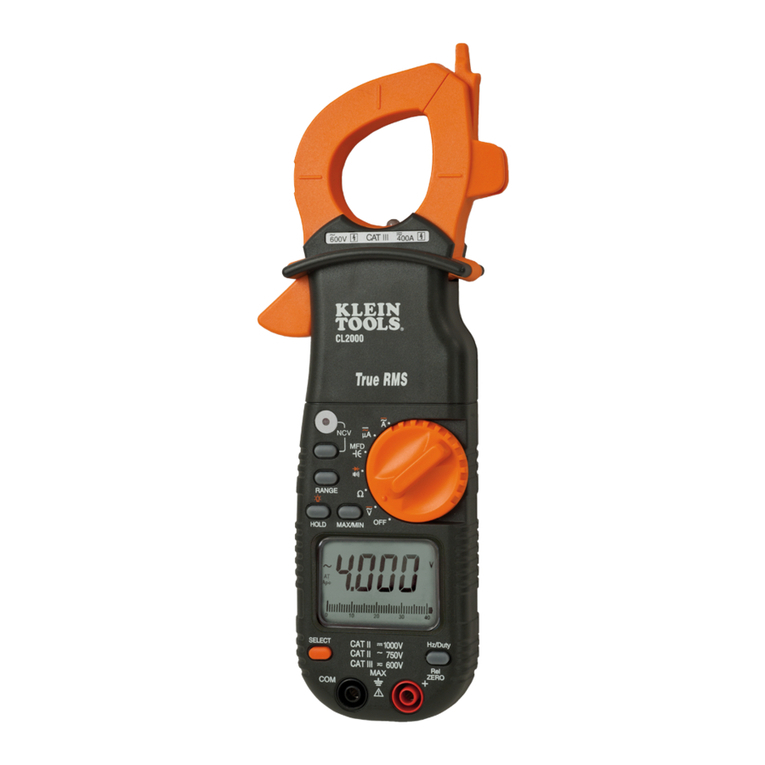
Klein Tools
Klein Tools CL2000 instruction manual
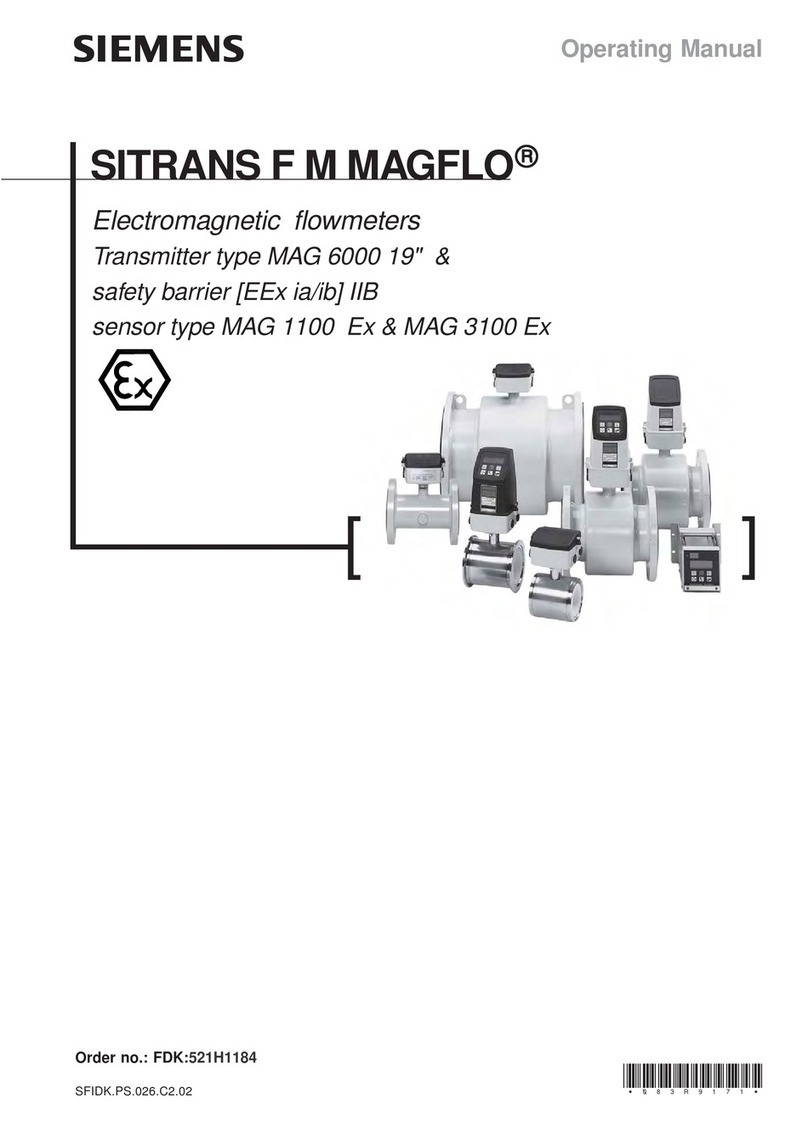
Siemens
Siemens SITRANS F M MAGFLO operating manual

ATAGO
ATAGO PAL-22S user manual
